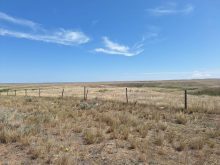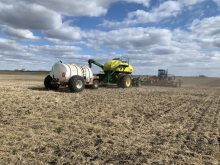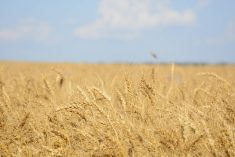GRAND BEND, Ont. — The second half of May delivered what Ontario farmers had been hoping for: warmer temperatures.
“Many areas of southern Ontario had the coolest April for 20 years,” said Geoff Coulson, a meteorologist with Environment Canada.
“May had also been running notably cooler than normal, up to 3 C cooler, which is a significant difference. We have now finally turned the corner on temperature … and that appears to be locking in.”
Pat Green, who owns Market Farm Equipment, which specializes in the design and manufacture of plastic augurs, said she’s heard from farmers across the province.
Read Also

Defence investments could benefit agriculture
A bump in Canada’s NATO spending commitments could lead to infrastructure investments that would benefit rural areas
She said temperatures have been on the cool side for everyone, but rainfall has varied.
It’s been too wet near the family business north of Grand Bend, but Green said she’s heard that most farmers a few kilometres north near Goderich and on the other side of the province near Ottawa have planted their corn and are working on soybeans.
“It’s has been spotty all over on the rain,” she said.
“We just had a gentleman in here yesterday. He said they just had rain in eastern Ontario and they welcomed its arrival.”
Green and other members of Ontario’s agricultural community spoke May 19, which was a warm, sunny day in the province.
Their mood may have improved from four days earlier, when snow and sleet fell on many areas of the province and there was a risk of damaging frost.
A 40-minute drive south outside Forest, Pete and Mary Donkers, retired hog producers, have 250 acres to plant.
They had hoped to get some corn into their fields, which is mostly Brookston clay, but excessive rainfall has forced them to change their plans.
“It sounds like the coming week will be better,” Pete Donkers said.
“We’re going to change everything to soybeans. We didn’t get any corn in. We had to change that idea.”
Soybean prices have improved in recent days, Donkers said, so while corn might be good for the rotation, soybeans could deliver a great return.
Like the Donkers, Pete Bertens said untimely rain has slowed his planting intentions at his farm near Brucefield.
There is far more winter wheat in Ontario this year because farmers took advantage of favourable weather last fall to plant the crop. Most fields came out of the winter in good shape.
Coulson said Environment Canada had been calling for average spring temperatures, given the mild winter.
Coulson said there are indications that temperatures in Ontario will be around the seasonable average, based on records for the past 30 years. He said the latest El Nino, which is characterized by warm temperatures in the Pacific Ocean off the coast of South America, has weakened from its peak last fall.















